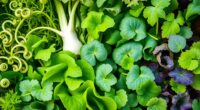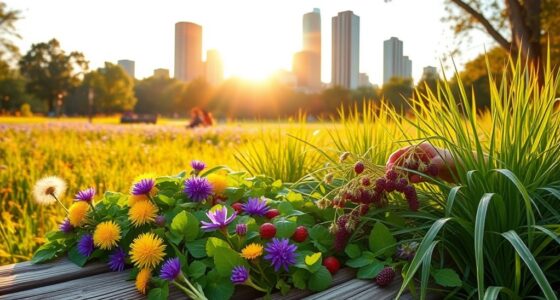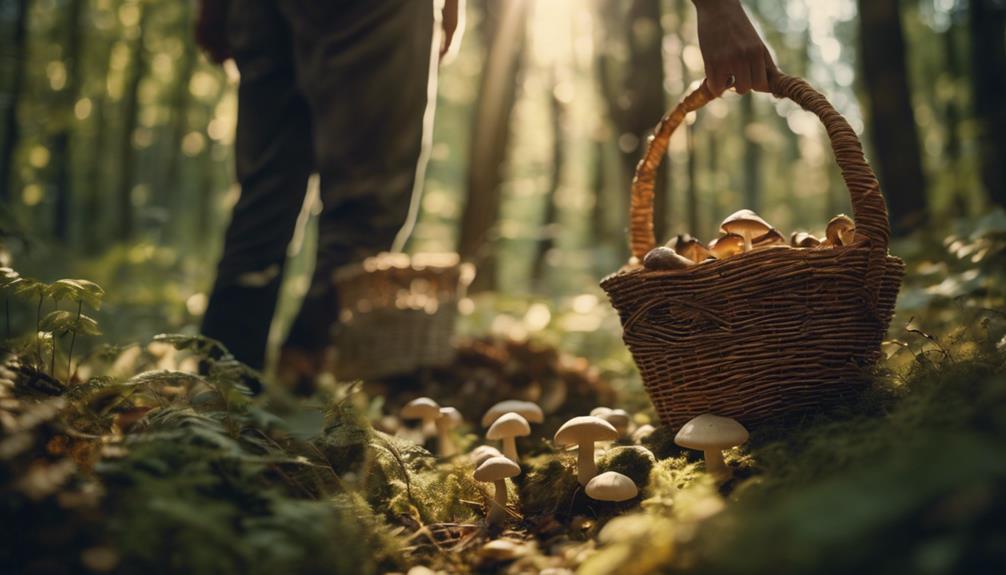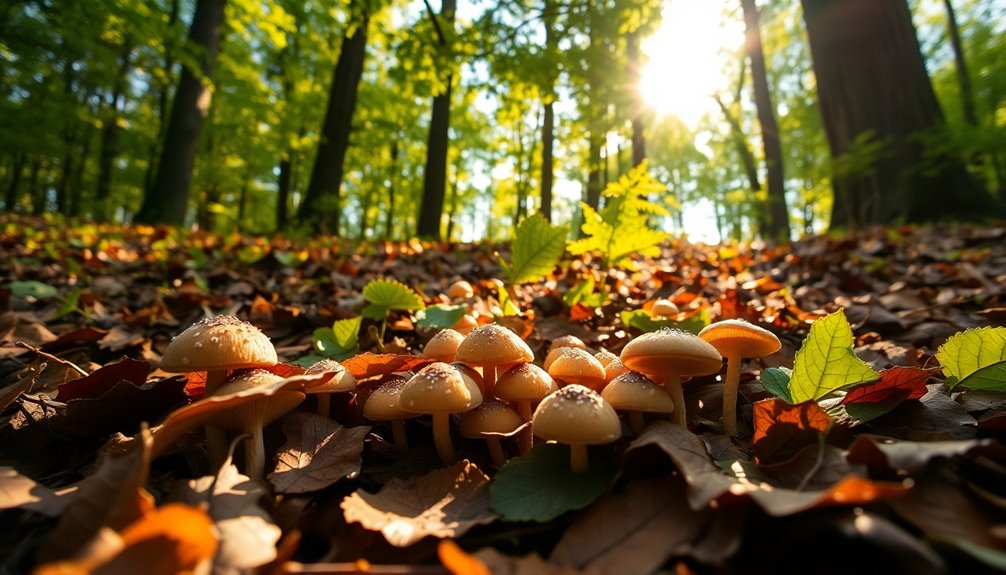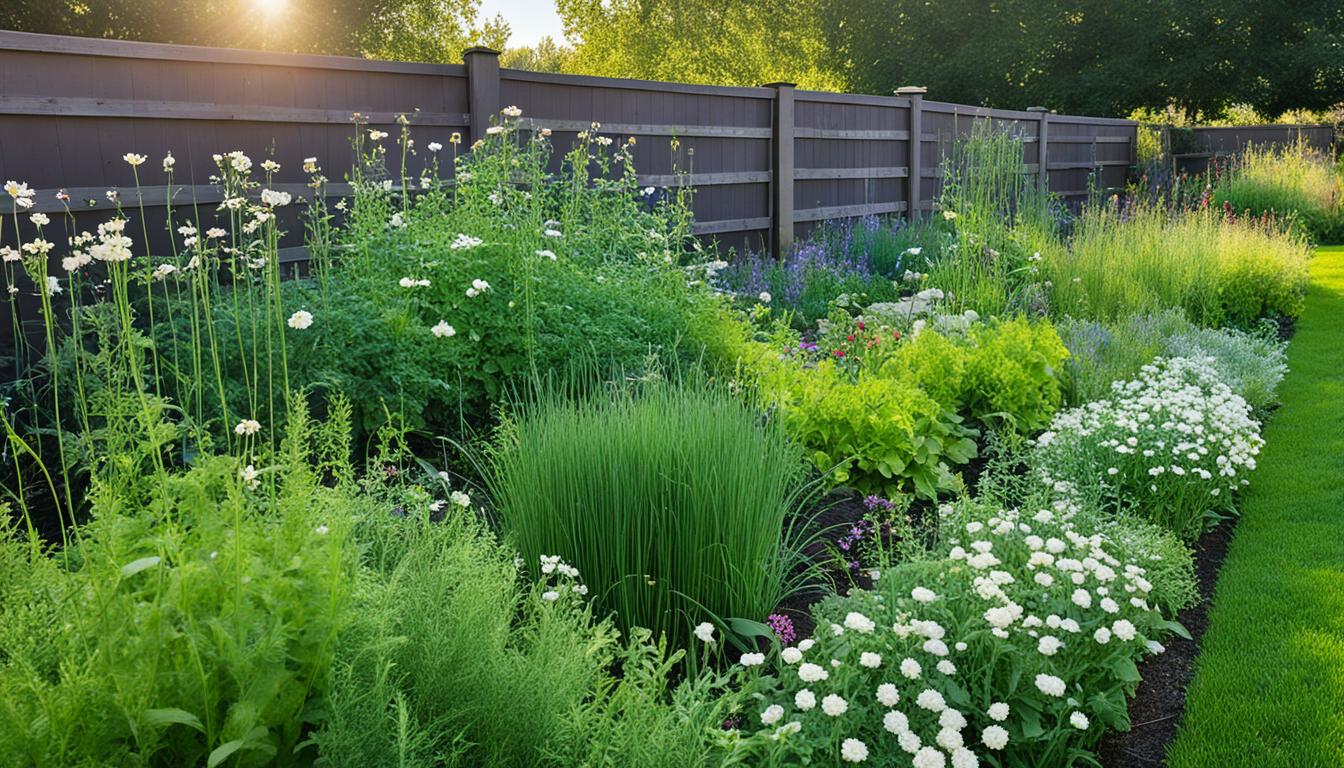To harvest wild garlic safely, start by accurately identifying the plant through its garlic-smelling, long, smooth green leaves and cluster growth. Be cautious of look-alikes like lily of the valley or deadly death camas, and avoid areas with pollution or heavy traffic. Use clean tools, harvest sustainably without damaging the roots, and wear gloves for protection. Following these steps guarantees a safe and responsible foraging experience; continue to discover more tips to protect yourself and the environment.
Key Takeaways
- Properly identify wild garlic by its scent, lance-shaped leaves, and cluster growth; avoid look-alike plants like lily of the valley.
- Harvest only young, vibrant leaves from healthy plants, leaving roots and some foliage intact for sustainable growth.
- Use sharp scissors or knives to cut leaves cleanly, preventing plant damage and promoting regrowth.
- Avoid harvesting from polluted, heavily trafficked, or protected areas to ensure safety and ecological responsibility.
- Wear gloves and carry appropriate tools to protect yourself from insects, thorns, and potential plant toxins during foraging.
Recognize the Characteristics of Wild Garlic

Wild garlic is easy to identify once you know what to look for. The plant emits a strong, garlic-like scent that’s unmistakable, especially when you crush its leaves. Its leaf shape is also distinctive: long, lance-shaped, with smooth edges and a vibrant green color. The leaves grow in a cluster from the base, forming a rosette that spreads outward. During spring and early summer, the plant produces tall, slender flower stalks topped with small white flowers, which further help in identification. Pay close attention to the plant’s scent and leaf shape, as these are your best clues to distinguish wild garlic from other plants. Recognizing these characteristics guarantees you collect the right plant safely and confidently.
Learn to Identify Toxic Look-Alikes

While wild garlic is relatively easy to identify, several poisonous plants look similar enough to cause confusion. Learning to distinguish them is vital for safe foraging. Focus on key features like leaf shape, smell, and bulb structure. Here’s a quick comparison to help you:
| Plant Name | Key Features | Toxicity Warning |
|---|---|---|
| Lily of the Valley | Small bell-shaped flowers, shiny leaves | Poisonous if ingested |
| Autumn Crocus | Striped bulbs, grass-like leaves | Highly toxic |
| Wild Onion | Similar smell, broader leaves | Less toxic, but caution |
| Death Camas | Grass-like, white flowers | Very poisonous |
| Poison Hemlock | Fern-like leaves, hollow stems | Extremely poisonous |
Master plant identification to avoid dangerous mistakes when foraging wild garlic. Recognizing subtle differences in plant features can significantly reduce the risk of misidentification, especially when plant identification skills are applied carefully.
Choose the Right Foraging Locations

Selecting the right foraging locations is essential to find healthy wild garlic and guarantee safety. Look for areas with well-drained soil conditions, as wild garlic thrives in moist, fertile ground without standing water. Avoid locations exposed to pollution or heavy foot traffic, which can contaminate plants. Seasonal timing matters too; the best time to forage is in early spring when the leaves are young and vibrant. Check local guidelines to ensure the spot is suitable and not overharvested. Wild garlic tends to grow in woodland edges, shaded meadows, and damp, grassy areas. By choosing these ideal spots at the right time, you increase your chances of harvesting robust, safe plants while supporting sustainable foraging practices. Additionally, understanding keto-friendly ingredients can help you incorporate wild garlic into low-carb recipes for a healthy diet.
Use Ethical Harvesting Practices
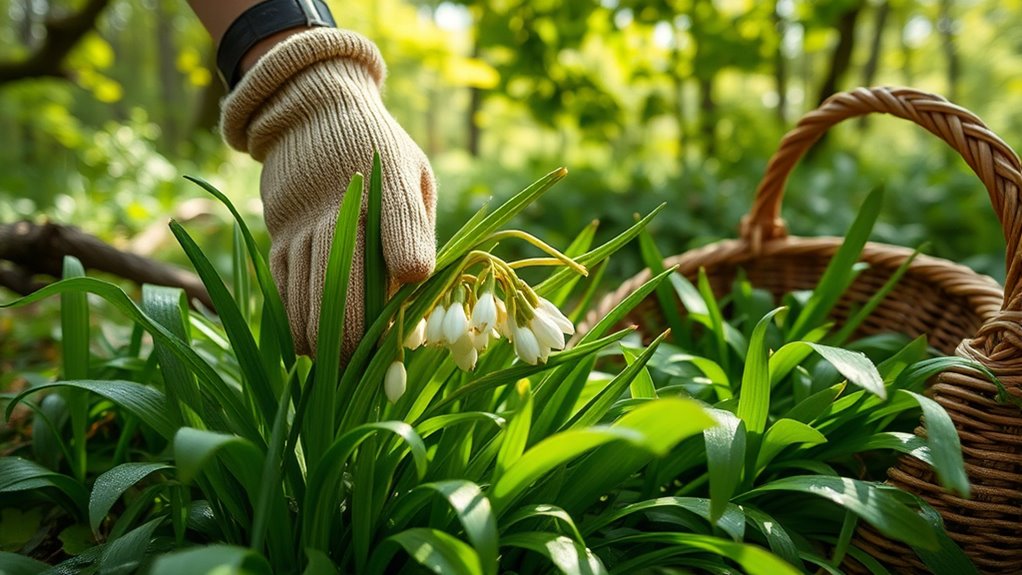
Practicing ethical harvesting guarantees you conserve wild garlic populations for future foragers and the ecosystems they thrive in. To guarantee sustainable harvesting, always take only what you need and avoid damaging the plant’s roots. This promotes conservation awareness and helps maintain healthy populations. When harvesting, focus on leaving enough leaves and bulbs behind so the plant can regrow. Use the table below to guide your practices:
| Do’s | Don’ts |
|---|---|
| Harvest from healthy plants | Over-harvest entire patches |
| Leave some leaves intact | Remove all foliage |
| Collect a small portion | Take more than necessary |
| Respect protected areas | Harvest in restricted zones |
Following these principles supports ecological balance and ensures wild garlic remains available for generations to come. Additionally, understanding the importance of sustainable harvesting can help you make more informed choices when foraging.
Tools and Equipment for Safe Foraging

Having the right tools and equipment is essential for safe and efficient wild garlic foraging. Proper garlic tools help you harvest without damaging plants or disturbing the environment. Foraging safety gear protects you from potential hazards like thorns, insects, and allergies. Using sharp scissors or a small knife ensures a clean cut, encouraging healthy regrowth. A basket or reusable bag prevents crushing your harvest and keeps it fresh. Additionally, carrying a field guide or app helps you accurately identify wild garlic and avoid mistaken plants. Essential foragers also wear gloves to protect your skin and eye protection if pruning near branches. With these tools, you’ll forage confidently while respecting nature and ensuring your safety.
Handling and Preparing Wild Garlic

Once you’ve gathered your wild garlic, it’s important to handle it carefully to preserve its freshness and quality. Rinse the leaves gently in cold water to remove dirt and debris, then pat them dry with a clean towel or paper towels. When preparing, consider your cooking techniques—wild garlic can be added raw to salads or cooked lightly to enhance flavor. Avoid overcooking, as this can diminish its delicate aroma and taste. For storage, keep the garlic in a breathable container, like a paper bag or a container with ventilation, in the refrigerator. Use it within a few days for the best flavor. Proper handling and storage guarantee your wild garlic stays fresh and flavorful, ready to elevate your dishes. Additionally, handling your wild garlic with clean hands and utensils helps prevent contamination and maintains its nutritional value.
Be Aware of Local Regulations and Permissions
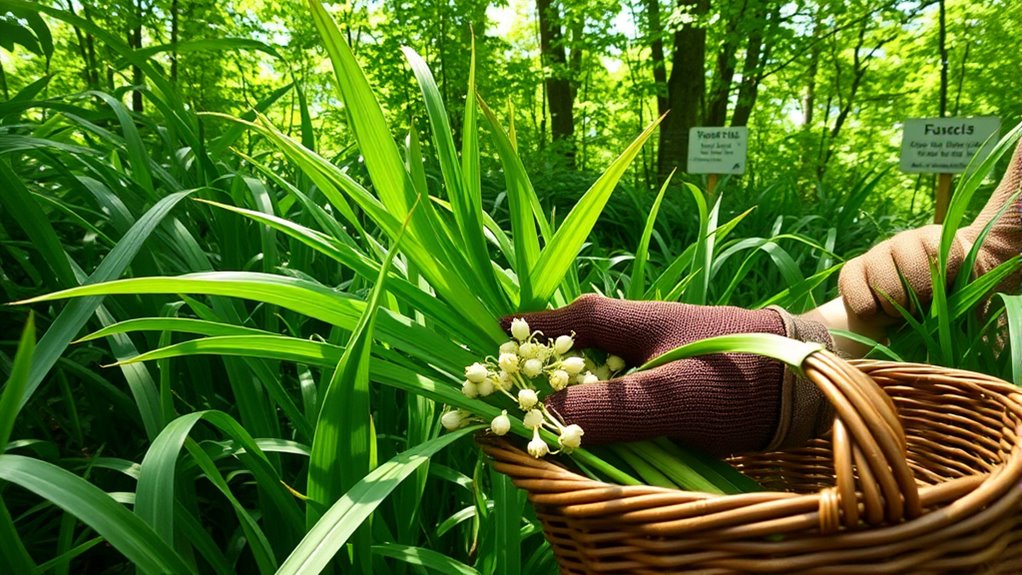
Before you start harvesting wild garlic, it’s essential to check local regulations and obtain any necessary permissions, as rules vary by area. Many regions require you to secure local permits or adhere to specific foraging laws to protect native plant populations. Ignoring these can lead to fines or damage to ecosystems. It’s also a good idea to familiarize yourself with copyright and affiliate disclosure policies if you plan to share your foraging experiences online. Being aware of local regulations ensures your wild garlic collection remains legal and eco-friendly. Always prioritize respecting the environment and the rules set by landowners or authorities. This way, you enjoy foraging responsibly and sustainably.
Stay Safe During Your Foraging Trip

While foraging for wild garlic, staying alert and prepared can prevent accidents and guarantee a safe experience. Prioritize foraging safety by keeping an eye on your surroundings and avoiding unfamiliar or hazardous areas. Wear appropriate clothing and sturdy footwear to prevent slips or injuries. Carry a fully charged phone and a basic first aid kit for emergency preparedness. Know how to recognize wild garlic accurately to avoid consuming toxic look-alikes. Stay close to your starting point and let someone know your plans before heading out. Avoid foraging alone if possible, and remain vigilant of terrain changes or wildlife encounters. Utilizing local resources and state-specific information can provide valuable guidance for safe foraging practices. By staying alert and prepared, you minimize risks, ensuring your wild garlic gathering remains a safe and enjoyable activity.
Frequently Asked Questions
Can I Forage Wild Garlic in Urban Areas Safely?
Urban foraging can be enjoyable, but you need to guarantee safe plant identification. In city areas, wild garlic is often found in parks or green spaces, but look closely to distinguish it from toxic plants. Always double-check your identification, avoid areas polluted with chemicals or traffic, and never harvest near busy roads. Taking these precautions helps you forage wild garlic safely, making your urban foraging experience both fun and secure.
How Do Weather Conditions Affect Wild Garlic Safety?
A stitch in time saves nine, they say, and weather conditions directly impact wild garlic safety. You should check soil moisture levels, as overly wet soil can cause plants to rot or absorb pollutants, while dry soil may result in weaker plants. Wind impact can spread contaminants or cause physical damage. Always harvest after good weather, avoiding stormy or overly windy days to make certain your wild garlic is safe and clean.
Are There Seasonal Risks When Harvesting Wild Garlic?
When harvesting wild garlic, seasonal risks depend on plant maturity and harvest timing. Early in the season, plants are tender but may not have enough flavor or nutrients. Waiting too long can lead to over-mature plants that are tough and less tasty, and increase the risk of confusion with toxic plants like lily of the valley. To stay safe, harvest when the plant is mature enough, but not overgrown.
What Signs Indicate Overharvesting or Plant Damage?
When harvesting wild garlic, watch for signs of overharvesting or plant damage. If the plant shows reduced vigor, such as sparse leaves or weak growth, it’s a sign of overharvesting. Additionally, frequent root disturbance can harm the plant’s health and longevity. To protect the population, only pick a few leaves from each plant and avoid digging around the roots. This helps guarantee the wild garlic can thrive for future seasons.
How Can I Store Wild Garlic to Prevent Spoilage?
A stitch in time saves nine, and proper garlic preservation guarantees freshness. To prevent spoilage, store wild garlic in airtight storage containers in the refrigerator. You can also freeze it by chopping and placing it in a sealed bag or container, preserving its flavor longer. Keep it dry and use within a week or two for ideal freshness. Proper storage helps you enjoy your harvest at its best, season after season.
Conclusion
Remember, safe foraging is like tending a garden—you must nurture knowledge and respect nature’s boundaries. When I first started, I almost took a toxic look-alike, reminding me how vital proper identification is. Just as a single misstep can ruin a harvest, rushing blindly can endanger you. Take your time, follow guidelines, and treat wild garlic with care. With patience and awareness, you’ll enjoy bountiful, safe foraging that connects you to nature’s delicious gifts.


